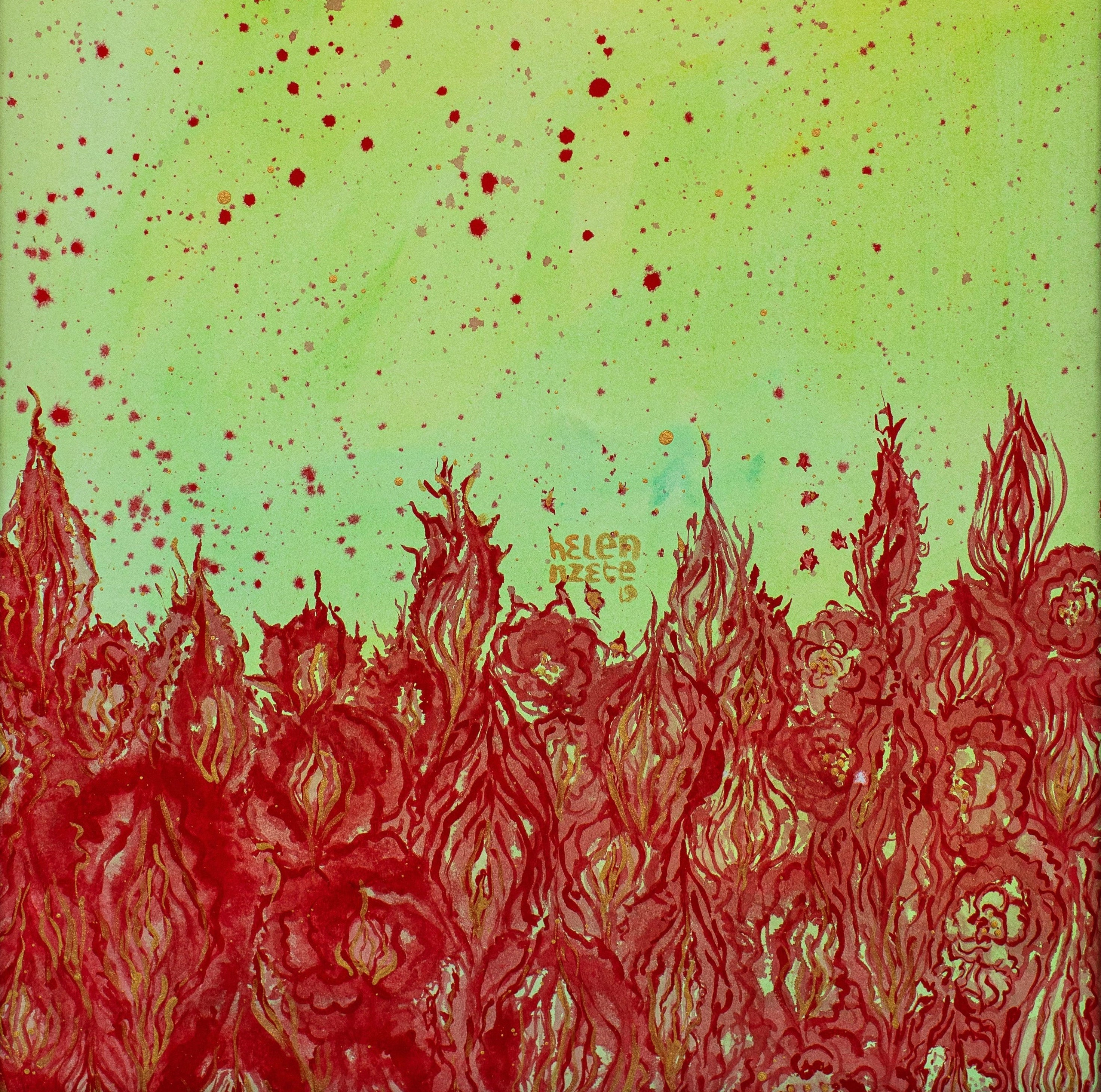
Sarah's Stories: Celebrating Nigerian Women in Contemporary African Art
Welcome to another episode of "Sarah’s Stories," my journey into the thriving contemporary art landscape where, this time, Nigerian women are in focus, as custodians and reshapers of the artistic heritage in Africa.
As previously mentioned, Nigeria has a rich history of art and academia, coined by prestigious institutions such as Zaria and Nsukka Universities (read more in Country in Focus: Nigeria). Another key contributor to Nigeria’s artistic development was the dynamic Mbari Mbayo Club in the 1960s and 1970s: This club was known for its artistic expression across various mediums – including painting, sculpture, theatre, music, and literature. It organised educational programs, workshops, and exhibitions in Osogbo, an important ritual town in southwestern Nigeria. Yet, in these academic spaces or artists' clubs, the presence of women was scarce, and their contributions were often overshadowed by the men in the club.
However, if we turn back time to the eras before the colonisation of Africa, I discovered that it was indeed the Nigerian women who formed the artistic pillars of their communities – their hands weaving the threads of cultural preservation through textiles, beadwork, and pottery. Their art was the heartbeat of household economies and a testament to their role as custodians of the ancestral legacy.
A prominent example of female artistic expression in Nigeria are the Yoruba people in the southwestern part of the country: Their art of tie and dye, known as "adire," creates the traditional Yoruba textiles known for their intricate patterns and dyeing with the indigo plant – and was mostly done by the skilled females of the community. This was not merely a craft, but a strong voice of artistic expression, and an avenue for economic empowerment.
The winds of change in the post-colonial era brought Nigerian female artists into the limelight, such as Clara Ugbodaga-Ngu, a post-modern pioneer; Afi Ekong, a formally trained artist who is said to have established the first private art gallery in Nigeria; and Nike Davies-Okundaye, a larger-than-life character with an incredible creative mind, driven by women's empowerment.
The Pioneer
In this blog article, I’d like to celebrate Nike Davies-Okundaye, a paragon of generosity and creativity. Nike emerged from humble beginnings and was strongly influenced by her great- grandmother, Madam Ibitola, an "adire" textile maker. In her younger years, she already shows her multifaceted artistic talents, expressing them through dance and acting. Her journey leads her to Osogbo, where she gravitates towards the Mbari Club, despite facing ostracism from the male-dominated art circles. She doesn’t give up though: With boldness, and the support of influential women like Susan Wenger and Victoria Scott, Nike forges her art path, transitioning from batik art to painting; she establishes her first gallery – "Africa Shop No. 1" – in her bedroom.
 Village series, ink and acrylic on canvas, Nike Davies-Okundaye. Courtesy of Okundaye This rich and intricate artwork might remind one of 'adire' patterns and exudes a dreamy vibe with its blend of people, animals, and rural scenes. It demonstrates Nike's creativity as she transitions seamlessly between various art forms, from adire to painting.
Village series, ink and acrylic on canvas, Nike Davies-Okundaye. Courtesy of Okundaye This rich and intricate artwork might remind one of 'adire' patterns and exudes a dreamy vibe with its blend of people, animals, and rural scenes. It demonstrates Nike's creativity as she transitions seamlessly between various art forms, from adire to painting.
Reaching a point of self-sustainability, Nike turns her focus to empowering rural women by initiating cottage weaving workshops across Nigeria, providing them with a voice and means of expression. She also plays a pivotal role in reviving "adire," engaging elderly women to pass down their expertise to younger generations.
 Nike Davies-Okundaye with her trademark towering gèlès (head tie). Courtesy of Okundale.
Nike Davies-Okundaye with her trademark towering gèlès (head tie). Courtesy of Okundale.
During her exhibitions in the US in the 1970s, Nike embraced the opportunity to learn and subsequently teach Nigerian women new techniques, such as quilting and applique, to further enrich the local art scene.
In 2009, Nike's vision culminated in establishing a five-floor ultra-modern cultural art centre in Lagos's Lekki Peninsula, transforming Nigeria's art and culture landscape and creating a central cultural hub. This centre, the 4th Nike Art Gallery, is West Africa largest Art Gallery and a key attraction for Lagos visitors (Nike Art Foundation: Abuja/ Lagos/ Oshogbo/ Ogidi-Ijumu – The Largest Art Gallery in West Africa).
Known affectionately as "Mummy" in her community, Nike, through her creative mind, generosity, talent, and boldness, continues to challenge the status quo by reviving Yoruba culture using rich aesthetics and symbols to sustain feminine power and foster an ecosystem for the arts. Her galleries, which serve as platforms for emerging artists, host unique exhibitions such as "Czech & Nigerian Heroines," highlighting her commitment to cultural exchange and celebrating female empowerment.

 “Czech & Nigerian Heroines” exhibition at Nike Art Gallery, Abuja, Nigeria
“Czech & Nigerian Heroines” exhibition at Nike Art Gallery, Abuja, Nigeria
Emerging Talents
As we look at the new generation carrying Nigeria’s strong legacy of female artists, we see bright stars on the horizon: This new generation is brimming with talent and determination.
We already introduced you to talented contemporary society commentator Helen Nzete. Now, I'd like to turn the focus to Uche Uguru. The first time I met Uche was in her studio in Abuja, where my friend and I met a tall, attentive young woman, who impressed us with her detailed and vibrant textures, her almost three-dimensional artworks. We were intrigued to see how what seemed simple collage could bring so much reality to the emotions and claims of her – mainly female – characters.
Mid-motion sketch giving a sense of casual movement, lines variety giving texture and depth bridging to life Izzi Ndono celebration.
Her work is a powerful platform for social commentary and advocacy. Reflecting on her journey, Uche shares, "My art has tremendously transformed with the times. Being an artist in Nigeria is challenging, because we're still growing as a nation."
Uche Uguru: Advocating for Change
Uche's recent exhibition, "The Reasons Why," delved into the complexities of migration, addressing the prevalent belief amongst the Nigerian youth, that success lies only abroad. Through her "Migration Series," she sheds light on the underlying reasons driving individuals to seek greener pastures elsewhere. Additionally, Uche collaborates with fellow female artists to highlight the strength and resilience of women, confronting societal constraints and perceptions.
Uche attributes her artistic journey to the constant support of mentors and teachers who believed in her abilities. She finds inspiration in her environment, family, and the stories of women, reflecting these influences in her captivating artworks.
Intricate sketch with cross-hatching and contour lines used to build up the features of expressive eyes, calm and serene expression to Queen Lupita.
Ultimately, Uche Uguru embodies the transformative power of art as a catalyst for social change. Her paintings challenge norms, amplify marginalised voices, and celebrate the resilience of women. As the art world embraces the contributions of women, Uche remains a trailblazer, inspiring others to harness their creativity for a more equitable society.
Uche, Helen and I have something in common: We are all women supporting women in the art community, and we are keen to spread the word. We believe that as more opportunities arise for female artists, society benefits. Through platforms like unx-art, we celebrate the intrinsic and singular aesthetic of African art globally, contributing to a more inclusive discourse in the art world.
Let's take this conversation to social media. Share this post, the art, and the stories of these incredible women using hashtags like #NigerianArtists and #WomenInArt. Together, we can amplify their voices and ensure their contributions are celebrated worldwide.







